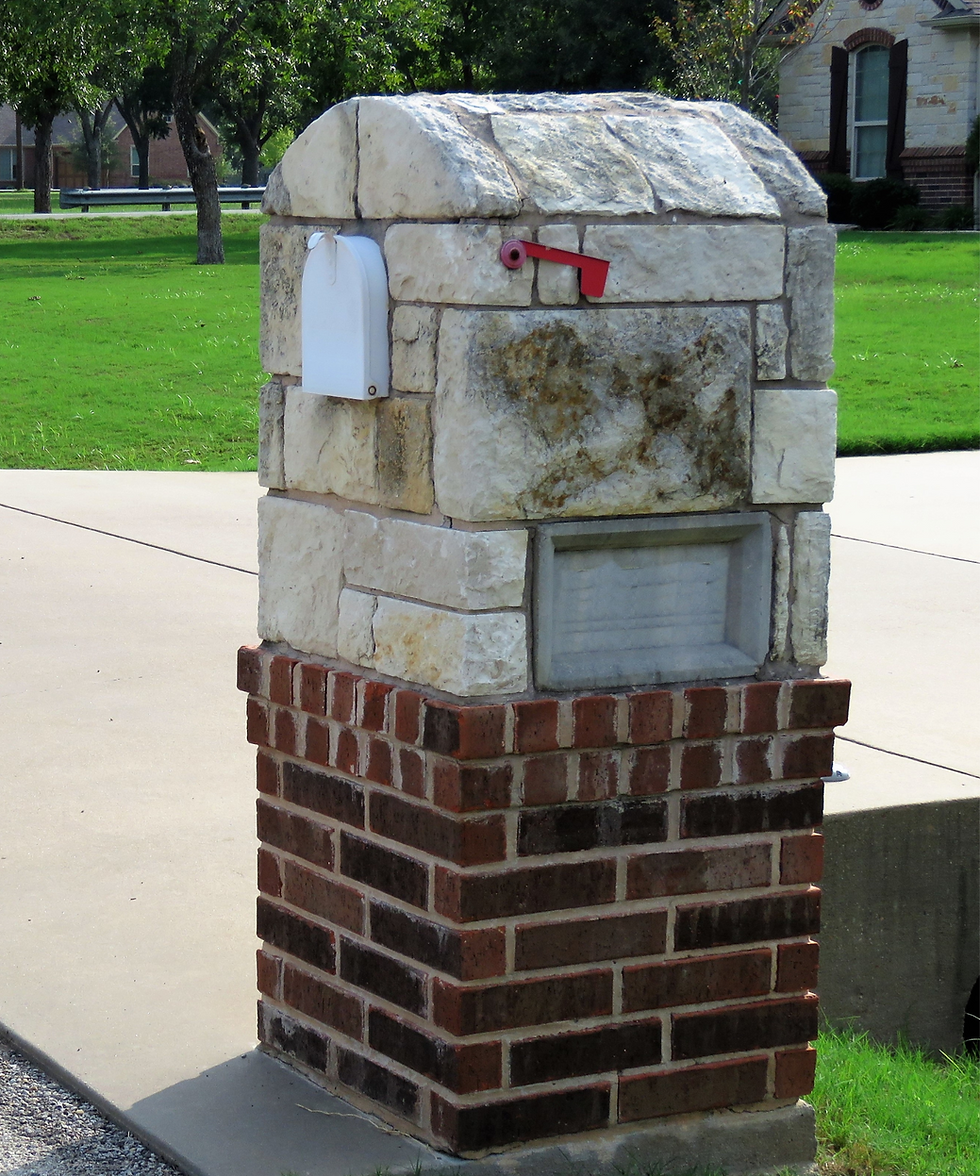The Stone Veneer Siding Guide: Costs, Pros & Cons
- srcustommasonry
- Mar 21
- 6 min read

If you’re looking for ways to boost the curb appeal and durability of your home, stone veneer siding is a popular option and it’s easy to see why. But before taking the leap, there are quite a few factors to consider. From the type of stone chosen to the project's overall scale and local labor rates, several factors influence the total cost of stone veneer siding. In this article we’ll break down these key elements, giving insight into what to expect and the expenses involved in upgrading with stone veneer.
What is Stone Veneer Siding?
Utah stone veneer siding is a decorative covering that mimics the look of natural stone without the weight or high cost. It's made from either natural stone cut into thin layers or manufactured materials designed to look like real stone. Homeowners love it because it adds a high-end, timeless look to their exterior without the hassle of full-stone construction.
Pros of Stone Veneer Siding in Salt Lake City
While stone veneer siding stands out for its durability and natural look, it's not the only option. Exterior faux siding panels and other competitive materials, like brick veneer or fiber cement, offer their own benefits. Here’s a quick comparison of the pros and cons of stone veneer siding versus similar materials.
Pros of Stone Veneer Siding
● Authentic Appearance – Offers the closest look to real stone.
● Long-lasting – More durable than many faux panel options.
● Weather Resistance – Handles harsh conditions better than some synthetic materials.
● Increases Home Value – Adds a high-end feel that can boost resale appeal.
● Versatile Design – Works well with different exterior styles.
Cons of Stone Veneer Siding
● Higher Cost – More expensive than faux siding panels or vinyl alternatives.
● Labor-Intensive Installation – Requires more prep and expertise than some other materials.
● Weight Considerations – Heavier than faux siding, which can add structural concerns.
● Maintenance Needs – Can require sealing and occasional repairs, especially in wet climates.
Comparison to Other Materials
● Faux Siding Panels – Lightweight, budget-friendly, and easier to install, but may not be as durable or realistic-looking.
● Brick Veneer – Strong and fire-resistant but usually more expensive and harder to install.
● Fiber Cement – Durable and low-maintenance but lacks the natural stone texture.
● Vinyl Siding – Affordable and easy to maintain but doesn’t offer the same high-end appearance.
Compatibility With Metal Siding
It may come as a surprise but stone veneer siding pairs really well with metal siding, offering a unique mix of rustic and modern design. The combination works great for homeowners who want a bold, stylish contrast while maintaining durability. Stone veneer brings texture and warmth, while metal siding adds a sleek, industrial edge. Together, they create a balanced, eye-catching exterior.
One of the biggest advantages of combining these materials is their shared durability. Both are weather-resistant, low-maintenance and can handle harsh conditions better than traditional wood or vinyl siding. Stone veneer works best as an accent around the foundation, entryways, or chimneys, while metal siding covers larger sections for a clean, modern look. When mixing these materials, it's important to consider installation and transition points. Proper flashing and moisture barriers are needed to prevent water damage where the materials meet.
Stacked Stone Veneer
Stacked stone veneer siding is a specific style that features tightly arranged, linear stone pieces with little to no visible mortar joints. Unlike traditional stone veneer siding, which often has defined grout lines, stacked stone creates a seamless, natural look. It’s commonly used for accent walls, fireplaces, and exterior facades, adding depth and texture. While both natural and manufactured options are available, stacked stone can be trickier to install due to its interlocking design, requiring precision for a clean, polished finish.
Interior Uses
\You don’t have to stick to the exterior to enjoy the look of stone veneer—it’s a great way to add warmth and texture inside, too. Since it’s lighter than full stone, it’s easier to install and way more budget-friendly. Whether you’re going for rustic, modern, or classic vibes, stone veneer works in all kinds of spaces and styles.
Popular Interior Applications
● Fireplace Surrounds – Stone veneer instantly upgrades a fireplace, making it the focal point of a living room or bedroom.
● Accent Walls – A stone veneer feature wall adds depth and character without overwhelming a space.
● Kitchen Backsplashes – For a bold, natural look, some homeowners use stone veneer as a backsplash, though sealing is necessary for easy cleaning.
● Entryways & Hallways – A stone-covered entryway or hallway creates a welcoming, stylish first impression.
● Home Bars & Wine Cellars – Stone veneer brings an old-world charm to home bars, basements, or wine storage areas.
Average Stone Veneer Siding Cost per square foot
The cost of stone veneer siding typically ranges from $4 to $18 per square foot, including materials and labor. Several factors influence the final price, with the type of stone veneer making the biggest impact. Natural stone veneer costs more than manufactured options due to its authenticity and durability.
Prices also vary based on stone type, texture, and color variations. While these features add uniqueness, they can also raise costs. Labor expenses are another major factor. Installing stone veneer siding requires skilled professionals, especially for detailed areas like accent walls or full exterior coverage. The process is labor-intensive, making installation costs a significant part of the total budget.
Several factors influence the cost of stone veneer siding beyond just materials and basic labor. Installation complexity plays a big role, especially if old siding needs removal or the surface requires preparation. Uneven walls, intricate designs, or working around windows and doors can add to labor time and expenses.
Costs to Consider
Keep in mind that there are several additional expenses that can affect the total price of stone veneer siding. Homeowners should plan for fees related to permits, delivery, underlayment, and potential removal of old siding. These costs vary by location and project scope but can add up quickly if not accounted for in the budget.
How to Install It
1. Prepare the Surface – Ensure the wall is clean, dry, and structurally sound. For exterior walls, install a weather-resistant barrier and metal lath for better adhesion.
2. Apply the Scratch Coat – Spread a layer of mortar over the lath using a trowel, then use a notched tool to create grooves. Let it dry before moving on.
3. Plan Your Layout – Before applying any stone, lay out the pieces on the ground to get a natural-looking pattern. Trim stones as needed with a masonry saw.
4. Apply the Mortar – Using a trowel, apply a layer of mortar to the back of each stone. Press it firmly onto the wall, slightly twisting it for a secure bond.
5. Fill the Gaps (If Needed) – Some styles of stone veneer have visible joints that require grout or mortar. Use a grout bag to fill gaps, then smooth with a joint tool.
6. Clean and Finish – Wipe away excess mortar with a damp sponge before it dries. If using a sealant for extra protection, wait until everything is fully cured.
7. Let It Set – Allow the mortar to cure for at least 24–48 hours before exposing the surface to heavy use or moisture.
Natural Stone Veneer Siding vs Faux Stone Siding
When choosing between natural stone veneer siding and faux stone siding, the biggest difference comes down to materials. Natural stone veneer is made from real stone cut into thin layers, offering an authentic look with unique textures and color variations. Fauxstone, on the other hand, is made from molded concrete or polyurethane designed to resemble real
stone. While both enhance curb appeal, natural stone provides unmatched depth and durability, while faux stone is lighter and often more affordable. Installation also varies between the two. Natural stone veneer requires more prep work since it’s heavier and needs a strong foundation for support. It’s also more labor-intensive, often requiring skilled masons for a professional finish. Faux stone siding is easier to install, as many panels interlock and don’t require mortar, making it a popular choice for DIYers or quick renovations. However, because it’s man-made, repeated patterns can sometimes make it look less realistic.
In terms of maintenance, natural stone veneer is more durable and resists fading or damage over time, but it may need occasional sealing to prevent moisture absorption. Faux stone siding is generally low-maintenance but may not last as long in extreme weather conditions, as some materials can crack or fade over time. Choosing between the two depends on budget, installation preferences, and long-term durability needs.
The Stone Veneer Siding Guide Conclusion
Stone veneer siding is a great way to add style, texture, and durability to your home’s exterior or interior. With options like natural stone, faux stone, and stacked stone, homeowners can find the right balance of budget, aesthetics, and installation needs. While it requires an upfront investment, its timeless appeal makes it a worthwhile upgrade.
If you’re thinking about installing stone veneer siding or need expert masonry work, our team at S&R Masonry is here to help. We specialize in high-quality stone and brickwork, handling everything from exterior siding and fireplaces to custom masonry projects. Our skilled professionals bring years of experience and a commitment to top-notch craftsmanship, ensuring every project looks incredible and stands the test of time.





Comments